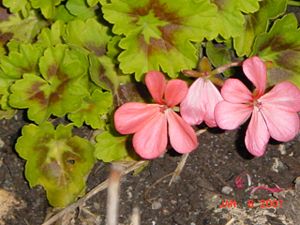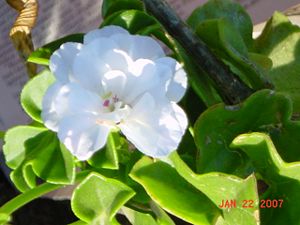Pelargonium
Pelargoniums are bushy flowering plants [1] in the Geraniaceae family, originating from Southern Africa. They are commonly called geraniums, because that is how they were originally classified, since Europeans noticed their similarity to true (botanical) geraniums, (which are now classed is a different genus), and called them South African Geraniums. True geraniums are sometimes called Cranesbills to help distinguish them from pelargoniums.
Pelargoniums are best distinguished from botanical geraniums by the shape of their flowers: they usually have two petals on top of the flower and three on the bottom, although in fancier varieties (with compounded petals or more than one layer of petals) this pattern can be hard to discern.[2] They can be roughly divided into four categories: Regal (Martha Washington), Zonal (so called because a coloured band divides the leaf into different "zones", ivy-leaved (because its leaves and climbing/trailing habit[3] resembles that of ivy or hedera) & scented-leaf pelargoniums. Most of the species in these categories are hybrids.[4]All pelargoniums are commonly grown; many are kept as house plants [5]
Pelargoniums are hardy, drought-tolerant and easily-propagated from stem cuttings, so they’re an easy plant for the novice to grow. Many are evergreen and flower throughout the year, and this adds to their popularity. Some can tolerate the occasional frost, but in general pelargonims are not frost-hardy and in cold climates must be brought indoors or treated as annuals.
Notes, sources and further reading
- ↑ Some pelargoniums can grow quite tall and bushy, but ABC's Gardening Australia Flora's Trees and Shrubs. ABC Books, Ultimo (NSW),(c) 2005, does not class them as shrubs
- ↑ http://www.newleafnurseries.com/gerpeldf/pages/gervspel.html. Sourced on 13 November 2007
- ↑ Habit is a horticultural term referring to the form of a plant, e.g. "a weeping habit".
- ↑ The Dave's Garden website davesgarden.com, is a good and easy-to-understand site where gardeners can ask and answer questions, and view photographs. Membership is required for communication, but a great deal of information is available free.
- ↑ The overwhelming majority of books on indoor plants make reference to pelargoniums. A novice seeking a specific type might be confused by the different names given to the same hybrids, even the scientific names can differ: for example, "lemon-scented geraniums" or "lemon geranium", a pelargonium, might be termed pelargonium crispum 'Variegatum' (Gilbert, Richard. 200 House Plants Anyone can Grow RD Press: Surrey Hills (NSW), 1988) or Pelargonium crispum 'Minor' (Weber, Angelika and Greiner, Karin, Success with Climbing Plants. Murdoch Books: Ultimo (NSW), 1998), which may indicate varieties of the same hybrid. A nursery might list any and all varieties as simply "lemon geranium" or Pelargonium crispum.

